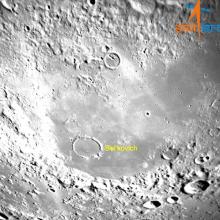Listen to today's episode of StarDate on the web the same day it airs in high-quality streaming audio without any extra ads or announcements. Choose a $8 one-month pass, or listen every day for a year for just $30.
You are here
Moon and Jupiter
The Moon shines big and bright tonight. It climbs into good view by about 11 p.m., and is well up in the southwest at first light tomorrow. And it has a big and bright companion: the planet Jupiter. It looks like a brilliant star to the upper left of the Moon as they rise, and to the right of the Moon at dawn.
By that time, the Moon will be about two and a half days past full. So for American skywatchers, the Sun will light up about 93 or 94 percent of the lunar disk.
You might think that means the Moon will be 93 or 94 percent as bright as the full Moon. And your eyes might seem to agree — since the Moon looks almost full, it must be almost as bright.
This is one of those times that you can’t trust your lying eyes, though. The pre-dawn Moon will be only half as bright as a full Moon. By comparison, when the Sun lights up half of the disk, it’s only one-sixth as bright as a full Moon.
One reason is that the lunar surface reflects sunlight most efficiently when the Moon lines up opposite the Sun — when it’s full.
The main reason, though, is that when the Moon is full, we don’t see many shadows — the central portion of the disk is in direct sunlight. At other times, though, the Sun is at a lower angle. Mountains, the rims of craters, and even big boulders cast shadows that make the surface appear darker. And the farther the Moon is from full, the longer the shadows — and the darker the Moon looks in our sky.






